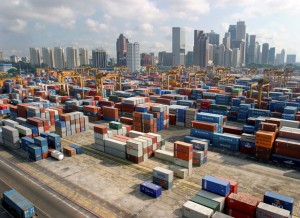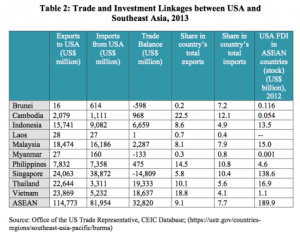http://www.bing.com/videos/search?q=south+east+asia+road+to+terrorism&FORM=VIRE1#view=detail&mid=CE8B345111B3656D5458CE8B345111B3656D5458
History:
Southeast Asia has been the home of indigenous Islamic militant groups for decades. Traditionally, the linkages among these groups were relatively weak, and most operated only in their own country or islands, focusing on domestic issues such as promoting the adoption of Islamic law and seeking independence from central government control. The Philippines has had a violent Muslim separatist movement for more than a century. The Moros of Mindanao and the Sulu Archipelago, including the island of Jolo, fought a stubborn, bloody, and ultimately futile insurgency against the American occupation of the southern Philippines following the Spanish American War. Until recently, however, the activities of several Muslim extremist groups in the Philippines had been confined mainly to the relatively isolated Muslim-majority regions in the South. In Indonesia, various schools of Islamic thought have competed for followers and public attention, but most have not called for an Islamic state. Moderate groups, both modernist and traditionalist formed the main legal opposition to the Suharto regime which ended in May 1998. Abdurrahman Wahid, the first democratically elected President after the collapse of the Suharto regime, and Amien Rais, currently speaker of the upper house of parliament, are leaders of the two largest Muslim political parties. Both have pursued a largely secular political agenda. Likewise, mainstream Islam in Malaysia has been largely apolitical, although the late 1990s saw a potentially significant electoral swing towards a radical Islamist party, which calls for making Malaysia an Islamic state. This party still only has 27 seats in the 193-seat parliament and controls just two of Malaysia’s 13 states, but at least until recent efforts by the Malaysian government to link Pas to Islamic extremists, its influence had been growing.
Asia is one of the most diverse regions not only culturally but also geographically. Asia has more than 48 countries with over 3.8 Billion people within its sub regions, which include East Asia, Central Asia, South Asia, Southeast Asia, West Asia, and North Asia.
Politics:
To date the Southeast Asian states that have witnessed the growth of Islamic-extremist terrorism are Malaysia, Singapore, the Philippines and Indonesia. The emergence of radical Islamic movements in Southeast Asia in the 1990s can be traced to the conjunction of several phenomena. Among these were reaction to globalization, which has been particularly associated with the United States in the minds of regional elites, frustration with repression by secularist governments, and the desire to create a pan-Islamic Southeast Asia, reaction to the Israeli occupation in the West Bank and Gaza Strip, and the arrival of terrorist veterans that have spent years fighting in Afghanistan. The forging of connections between Al Qaeda and domestic radical Islamic groups in Southeast Asia is part of this trend.
Indigenous populations had fallen behind economically when colonialism ended. The Muslim governments in Malaysia and Indonesia have devoted significant political energies to trying to improve the status of their less well-off brethren but great gaps remain between the elites and the masses. The Muslim minorities in Chinese Singapore and Catholic Philippines have not fared as well. The Philippines is a special case because Spain pursued a Christianizing mission against Islam, which eventually limited Islam only to Mindanao and the southern islands. In general, whether in Muslim majority or minority states, poor Muslims have a sense of grievance that makes them potentially vulnerable to extremist agitation and pose significant problems for contemporary post-colonial governments. This sense of grievance has reinforced Islam’s role as a medium for asserting identity. The external manifestation is the wearing of Middle Eastern clothes by men and women. Moreover, women have increasingly worn headscarves or even gone fully covered despite the tropical heat. Additionally, strict observance of fundamentalist Islam is also a means of asserting identification with reform and protesting upper-class corruption.
Table 2: Ten countries with the most terrorist attacks, 2013
| Country | Total Attacks | Total Killed | Total Wounded | Average Number Killed per Attack | Average Number Wounded per Attack |
| Iraq | 2495 | 6378 | 14956 | 2.56 | 5.99 |
| Pakistan | 1920 | 2315 | 4989 | 1.21 | 2.60 |
| Afghanistan | 1144 | 3111 | 3717 | 2.72 | 3.25 |
| India | 622 | 405 | 717 | 0.65 | 1.15 |
| Philippines | 450 | 279 | 413 | 0.62 | 0.92 |
| Thailand | 332 | 131 | 398 | 0.39 | 1.20 |
| Nigeria | 300 | 1817 | 457 | 6.06 | 1.52 |
| Yemen | 295 | 291 | 583 | 0.99 | 1.98 |
| Syria[2] | 212 | 1074 | 1773 | 5.07 | 8.36 |
| Somalia | 197 | 408 | 485 | 2.07 | 2.46 |
Terrorism in Southeast Asia has various manifestations because of its historical complexities and current political realities. Andrew T. H. Tan formulated a four-class division of terrorism and insurgency to highlight the complexities of terrorist threats in the region.
- The first division consists of separatist insurgencies that utilize terrorism as part of their tactics. These separatist groups are marginalized and regarded as victims of political exclusion. They carry the features of long-running civil conflicts that pose great challenge to the legitimacy of existing regimes in the region.
- The second division pertains to armed anti-government political opposition groups created to address some deeply-rooted political, economic and social grievances. These groups have “special
- The third division refers to radical Islamist groups aiming to establish an Islamic State through the violent overthrow of the existing governments in the region. These groups justify the use of terrorism through its violent extremist ideology. Groups belonging to the third category are linked to Al-Qaeda and/or part of what is called the Afghan mujahedeen network.
- The fourth division is largely based in Indonesia. It pertains to overt and legitimate radical organizations that are sympathetic to radical Islamist groups. Though these groups assert their right to participate in the democratic political process, Tan argues that these groups have the potential to use violence because of their ideological and personal associations with groups involved in terrorist acts.
Globalization
Trade:
With an average annual economic growth rate of more than five percent, the countries that comprise this dynamic region represent a thriving trade and economic hub, despite infrastructure and regulatory challenges.
South Asia as a region is peculiar. Its trade, capital flows, and economic management differ from other regions in how the region has globalized, although it must be mentioned that there is a lot of diversity within the region.
Its trade characteristics are different from that of East Asia. While East Asia benefitted from an export led growth strategy based on manufactured goods, the size of manufacturing sector in South Asia is relatively small. There are some examples of success in garment exports from Bangladesh/Sri Lanka, and in this sense its experience is no different from East Asia. But most South Asian countries have much larger service sectors. They seem to have benefitted more from modern service exports and traditional service exports such as remittances.
Asian Financial Crisis:
“The Asian financial crisis that was triggered in July 1997 was a shocker. Even two years after it ended, anxiety still loomed over global financial markets. What was at the time perceived to be a localized currency and financial crisis in Thailand, soon spread to other Southeast Asian countries–including Malaysia, Indonesia and the Philippines. By the fall of 1997, the contagion extended its reach to South Korea, Hong Kong and China. A global financial meltdown had been ignited. In 1998, Russia and Brazil saw their economies enter a free-fall, and international stock markets, from New York to Tokyo, hit record lows as investors’ confidence was shaken by the volatility and unpredictability in the world’s financial markets.” –Frontline PBS
Overview http://www.pbs.org/wgbh/pages/frontline/shows/crash/etc/cron.html
Since Asia’s financial crisis, the region’s infrastructure needs have almost exclusively been met by the state. But the requirements are now so large, and the demand for quality so great, that the way Asian infrastructure is being financed is undergoing a profound change.
Many governments are now actively courting private involvement. Over the next 10 years, $1 trillion of the region’s projected $8 trillion in infrastructure projects will be open to private investors under public-private partnerships.
Values and Obligations
Traditional Asian families value culture as a hierarchy in structure, with males and older individuals occupying a higher status. There are gender differences between Asian males and females. Males are highly valued and most families want sons because males are important to carry on the family name (lineage). Females are valued less than males and have a less important role in the family. The role of the female is to be passive and to adhere to husband’s family, be subservient to the male, perform domestic chores, and bear children. The role of the male is to provide for the family. Their primary duty is to be a good son. There are also obligations to be a good husband and father come second to duty as a son. The customary thought of people is that “girls are born to be fed throughout their lives” and “boys are born to earn and support the whole family”.
The Asian culture values a patriarchal relationship in which the husband dominates the household. There is a high level of respect for ancestors and elderly (past-present time orientation). There is also a strong loyalty for authority figures.
Communications is viewed as one-way street with adults addressing children. Children learn early in life that the family is central & the primary unit and that the behaviors of individual members are a reflection on the entire family.
Discipline, shame, and guilt are used to control and train children. There is an emphasis of loyalty and honor to the family and avoidance of shame and embarrassment to the family. Family problems are hidden from public and handled within the family. Mental illness is shameful and represents family failure. However, outstanding achievement: source of great pride for child and entire family.
In regards to emotions, there are fewer displays of emotions as this symbolizes maturity and self-control. Care and concern is shown by supplying physical needs of family members.
This thought is reflected through certain discriminative behaviors of people. In this region, some ancient traditions and customs are still followed promoting various forms of violence against women. These include honor killings, exchange marriages, marriage to Quran, Karo-kari, bride price, dowry, female circumcision, questioning women’s ability to testify, confinement to home, denying their right to choose the partner. In some rural areas of Sindh, Pakistan and Punjab, India, girls are deprived of their marriage rights only to keep the property in the family. A cruel custom asking the girl to swear on Quran that she will leave her share of property to brothers adds misery to the already miserable lives of these incarcerated women.
The cultural norms prevailing in South-East Asia perpetuate the subordinate position of women socially and economically. In this region, very often young unmarried girls and women suffer tremendous physical and psychological stress due to the violent behavior of men. The nature of violence includes wife-beating, murder of wife, kidnapping, rape, physical assault, and acid throwing. The most frequent causes for acts of violence are domestic fights due to the inability of a woman’s family to make dowry payments at time of marriage.
Even in the new millennium, women in South Asia are deprived of their socio-economic and legal rights. They live in a system where religious injunctions, tribal codes, feudal traditions and discriminatory laws are prevalent. They are beset by a lifetime of social and psychological disadvantage, along with long years of child bearing. They often end up experiencing poverty, isolation and psychological disability.
Solutions:
In its effort to handle terrorism, Indonesia is consistent in legal supremacy and does not need to use missiles like other countries. Therefore, Indonesia becomes the model world terrorist handling, Indonesia was considered successful in handling terrorist without involving a number of large forces like that in other countries. The Indonesian counter-terrorism squad Special Detachment 88 (Densus 88) was able to work well in handling terrorism in the country. Indonesia was admired by many countries because the Densus 88 was able to arrest a number of terrorists.
Also Countries that aren’t as economically strong as Indonesia should take a unilateral approach and seek the help of the United States and China because stability in the region is important to the international community.






test candice